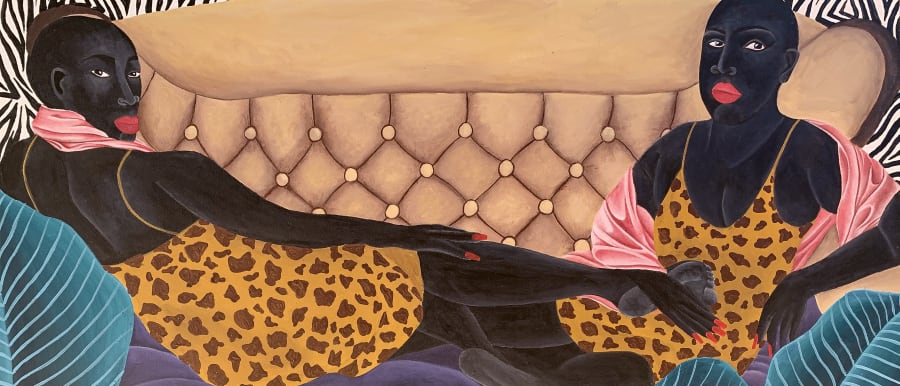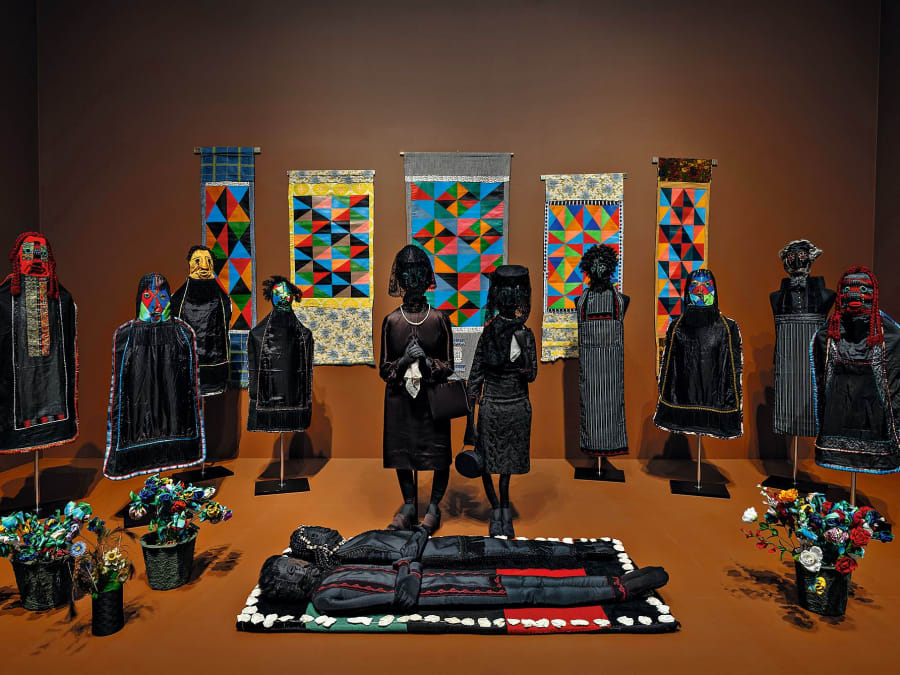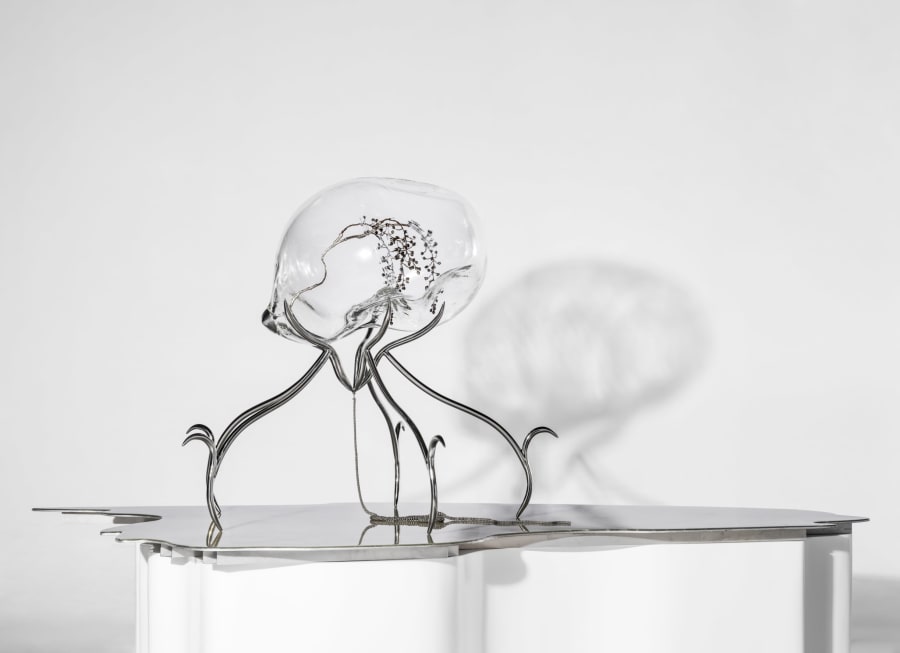Curated for the first time by Stefanie Hessler, Director of the Swiss Institute in New York, this year’s Parcours sector explores transformation and circulation in trade, globalization, and ecology processes. Hessler’s design weaves together 22 projects through empty stores and operational shops, a hotel, a restaurant, a distillery, and other everyday spaces on Basel’s Clarastrasse, the street running from Messe Basel to the river and connecting the new part of the city to the old town. Be sure to see these seven highlights.
Iris Touliatou
mothers, 2022-2024
Presented by Sylvia Kouvali
If you’re feeling the heat during Art Basel week, head over to mothers (2022-2024), Iris Touliatou’s installation of water fountains at Hotel Rheinfelderhof. Resembling the fixtures found in schools or libraries, these drinking fountains are connected to the hotel’s water system during the fair so as to be fully functional.
Inviting viewers to use the installation for refreshment and to cool down, Touliatou portrays the fountains as nurturing figures – the ‘mothers’ of the title – while challenging water privatization and the inflation of basic resource prices. In previous exhibitions, the artist negotiated with institutions to offer free admission during hot summer months, providing the public with access to both art and fresh water.
Stephanie Comilang
Search for Life, 2024
Presented by ChertLüdde, with additional support from Daniel Faria Gallery
Each year, monarch butterflies undertake an epic migration from sub-Saharan Africa to the Arctic Circle – across six generations, descendants have continued on the path initiated by their ancestors. However, those that embark on the journey do not return. Artist Stephanie Comilang highlights a connection between the monarchs and human migration in her installation Search for Life (2024), displayed in a window of the HQ of Bajour, a youth online magazine, on Clarastrasse. A continuation of themes from her 2024 film of the same name, the installation features a floral arrangement and four textile sculptures crafted from piña fabric using traditional Filipino techniques. Each sculpture is embroidered with butterfly motifs alongside pixelated flowers symbolizing trade routes between Spanish colonies.
Dominique Gonzalez-Foerster, in collaboration with Paul B. Preciado
In remembrance of the coming alien (Alienor), 2022
Presented by 303 Gallery, Galerie Chantal Crousel, Jan Mot, and Esther Schipper, with additional support from Albarrán Bourdais
Is humanity alone in the universe? Dominique Gonzalez-Foerster suspects not, and she feels that that is a good thing. Made in collaboration with writer and philosopher Paul B. Preciado, the sculpture In remembrance of the coming alien (Alienor) (2022) continues Gonzalez-Foerster’s longstanding interest in science fiction and extraterrestrial life.
A fusion of historical references and futuristic speculations, the work consists of two symmetrical groupings of pale-pink and mustard-yellow metal tubes that stretch and curve toward the sky. The sculpture’s rounded form pays tribute to Le Corbusier’s ‘The Modulor’, a measurement system that uses human proportions to create harmonious architectural designs, while its title nods to Eleanor of Aquitaine [‘Aliénor d’Aquitaine’ in French], the reigning queen of France from 1137 to 1152. Symbolizing hope and optimism, the sculpture serves as a portal to bridge past and future encounters.
Nina Canell and Robin Watkins
Energy Budget, 2024
Presented by 303 Gallery, kaufmann repetto, Mendes Wood DM, and Barbara Wien
A little-known fact: thanks to their electrostatic properties, the feathers of female ostriches are exceptionally effective at trapping dust, with each feather’s tiny barbules attracting and holding individual particles.
Installed inside a curved car ramp leading to a bunker beneath the fair, Nina Canell and Robin Watkins’s new video Energy Budget highlights the use of female ostrich feathers in dust-free car manufacturing environments. Showing a car on a slowed-down conveyor belt, the video is the third chapter of Energy Budget (2017–), a project that explores the circulation of material agency and its energetics.
Ximena Garrido-Lecca
Conversion systems, 2019
Presented by Galerie Gisela Capitain
In Ximena Garrido-Lecca’s installation Conversion systems (2019), traditional Peruvian aesthetics are juxtaposed with industrial practices. The installation comprises a group of freestanding sculptures in curved shapes resembling oil purifiers, crafted from both peach-colored traditional ceramics and cold, shining steel.
Garrido-Lecca’s practice delves into how globalization impacts Peru’s sociopolitical climate and traditional ways of life. The artist focuses her attention on Lobitos, a town in the north of the country that has witnessed numerous power shifts due to exploitation by foreign countries for its resources. Symbolizing the clash between indigenous traditions and industrial interests in the region, Conversion Systems serves as a poignant reminder of the complex and uneven relations across culture, economy, and environment.
Edith Deyerling
Dare Me Do – Touch Me Too, 2024
Presented by Felix Gaudlitz
Repeated encounters with an artwork can often lead to fresh insights and revelations. Sometimes, when you see a work for the second time, the difference is like night and day. Such is the case – literally – with Edith Deyerling’s abstract, gestural paintings, installed at Claraplatz. Seen during daytime, the works appear fixed, with lines and shapes suggesting symbols, hands, faces, and eyes. However, when darkness falls, each painting’s hidden life is revealed. By incorporating into her traditional materials glow-in-the-dark paints and ultraviolet colors, which cannot be seen by the naked eye under normal light, the artist layers her works with secondary compositions that emerge only at night when UV lights illuminate the window.
Tadáskía
the black trans ladies, 2024
Presented by Fortes D’Aloia & Gabriel
Fluttering on flagpoles at Claraplatz is the black trans ladies (2024), a series of flags reproducing colorful and abstract drawings by Brazilian artist Tadáskía. The artist sees the work as both a reimagining of the transgender flag and as a narrative about Black trans women interacting with the cosmos. Against watercolor backgrounds of white, blue, and pink, each flag features intricate, abstract characters originally rendered in colored pencil. Some characters greet the sun, others frolic outdoors, many kiss one another, while some pose together with proudly outstretched limbs. As the flags move in the wind, the figures appear to be in flux, mirroring the fluidity and multifaceted nature of the trans experience.
Elliat Albrecht is a writer and editor based in Canada. She holds a BFA in Critical and Cultural Practices from Emily Carr University of Art + Design and an MA in Literary and Cultural Studies from the University of Hong Kong.
Learn more about the Parcours sector of Art Basel in Basel, from June 13 to 16, 2024, here.
Caption for header image: Installation view of Iris Touliatou’s works untitled (diversion), untitled (oral) and untitled (still not over you), 2022, in the exhibition ‘appendage’ at Grazer Kunstverein. Photograph by kunst-dokumentation.com. Courtesy of the artist and Grazer Kunstverein.
Published on May 31, 2024.


